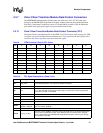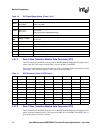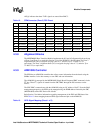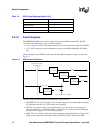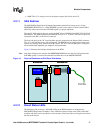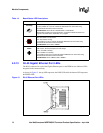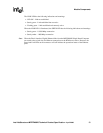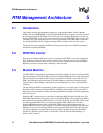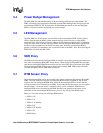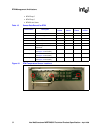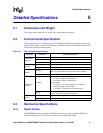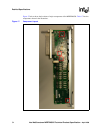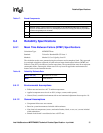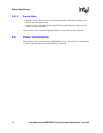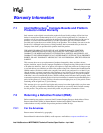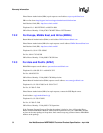
Intel NetStructure
®
MPRTM0020 Technical Product Specification – April 2006 31
RTM Management Architecture
5.4 Power Budget Management
The SBC IPMC has inherent knowledge of the non-intelligent RTM power requirements. The
IPMC will handle power negotiation commands from the Shelf Manager that are targeted for the
non-intelligent RTM FRU ID. By doing this, the Shelf Manager should see the non-intelligent
RTM as a separate controller negotiating for a power budget.
5.5 LED Management
The SBC IPMC has direct control over the LEDs on the non-intelligent RTM. Control of these
LEDs is done through the IPMC system attention manager in the same way as other IPMC-
controlled LEDs. Special fault classes are added to system attention manager tables to handle the
failure and status state of the non-intelligent RTM. The non-intelligent RTM sensors and M-State
machine are the contributors to the failure and status state. When the non-intelligent RTM is
present, its failures will contribute to the overall failure state of the IPMC. Thus, the non-intelligent
RTM LEDs will match the SBC LEDs.
5.6 SDR Proxy
The SDR records for the non-intelligent RTM are stored in a proprietary format in the internal use
area of the non-intelligent RTM FRU storage device. When the non-intelligent RTM reaches M1
state the non-intelligent RTM SDR records are read out of the FRU device and stored in the IPMC.
The non-intelligent RTM SDR records are then merged with the IPMC SDR records and made
available through the Device SDR IPMI commands.
5.7 RTM Sensor Proxy
The non-intelligent RTM sensors are included in the sensor compliment programmed in the SBC
IPMC. The only difference is that the non-intelligent RTM sensors are turned on and off with
respect to the non-intelligent RTM M-State. When the non-intelligent RTM is in M4 state the
sensors are turned on and scanned by the IPMC. In any other M-state the sensors are not scanned
and will return a “sensor not found” completion code to sensor commands. When the non-
intelligent RTM sensors are turned on the IPMC handles event generation and sensor access
commands for the non-intelligent RTM sensors just as it does for any other IPMC sensor.
Below is a list of the current non-intelligent RTM sensors:
• RTM +1.8V
• RTM +3.3V
• RTM +3.3V Standby
• RTM +5.0V
• RTM +5.0V Standby
• RTM +12V
• RTM Temp1



